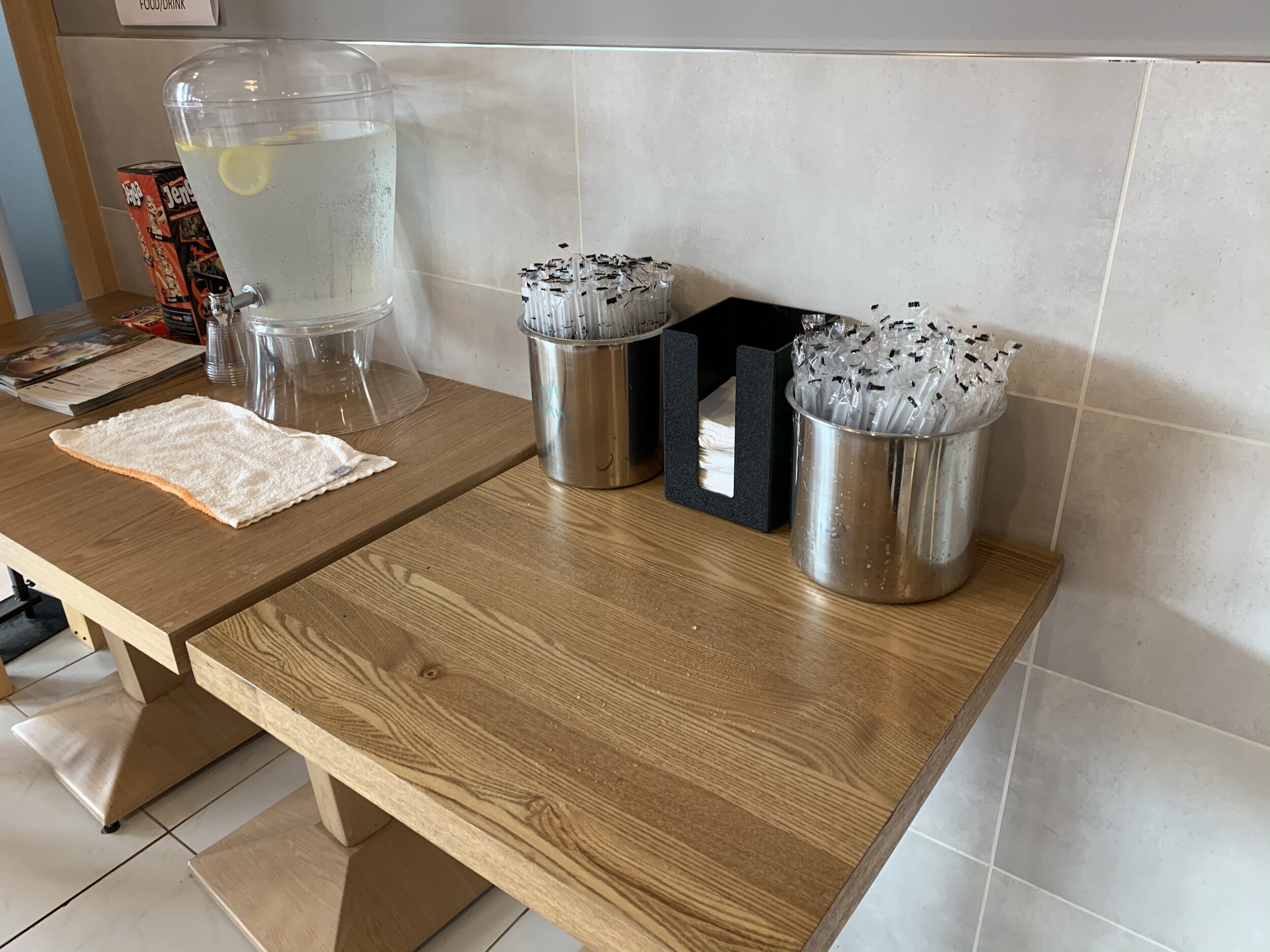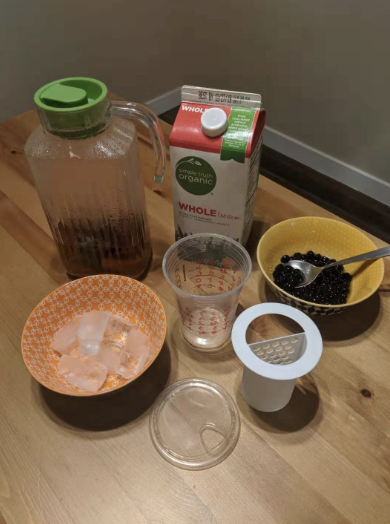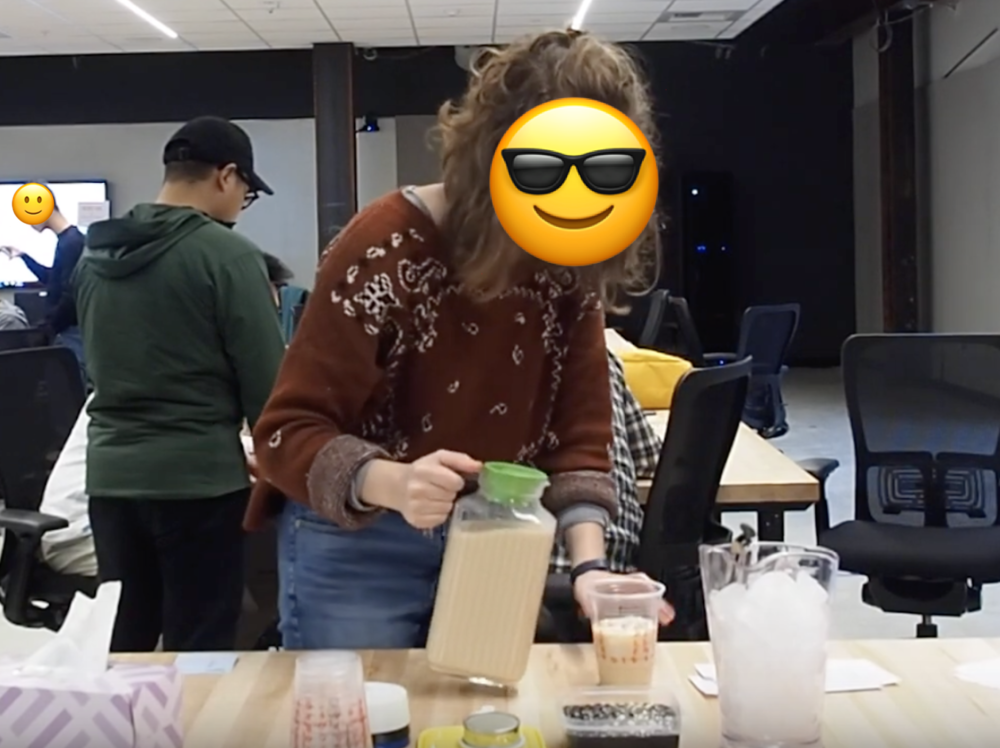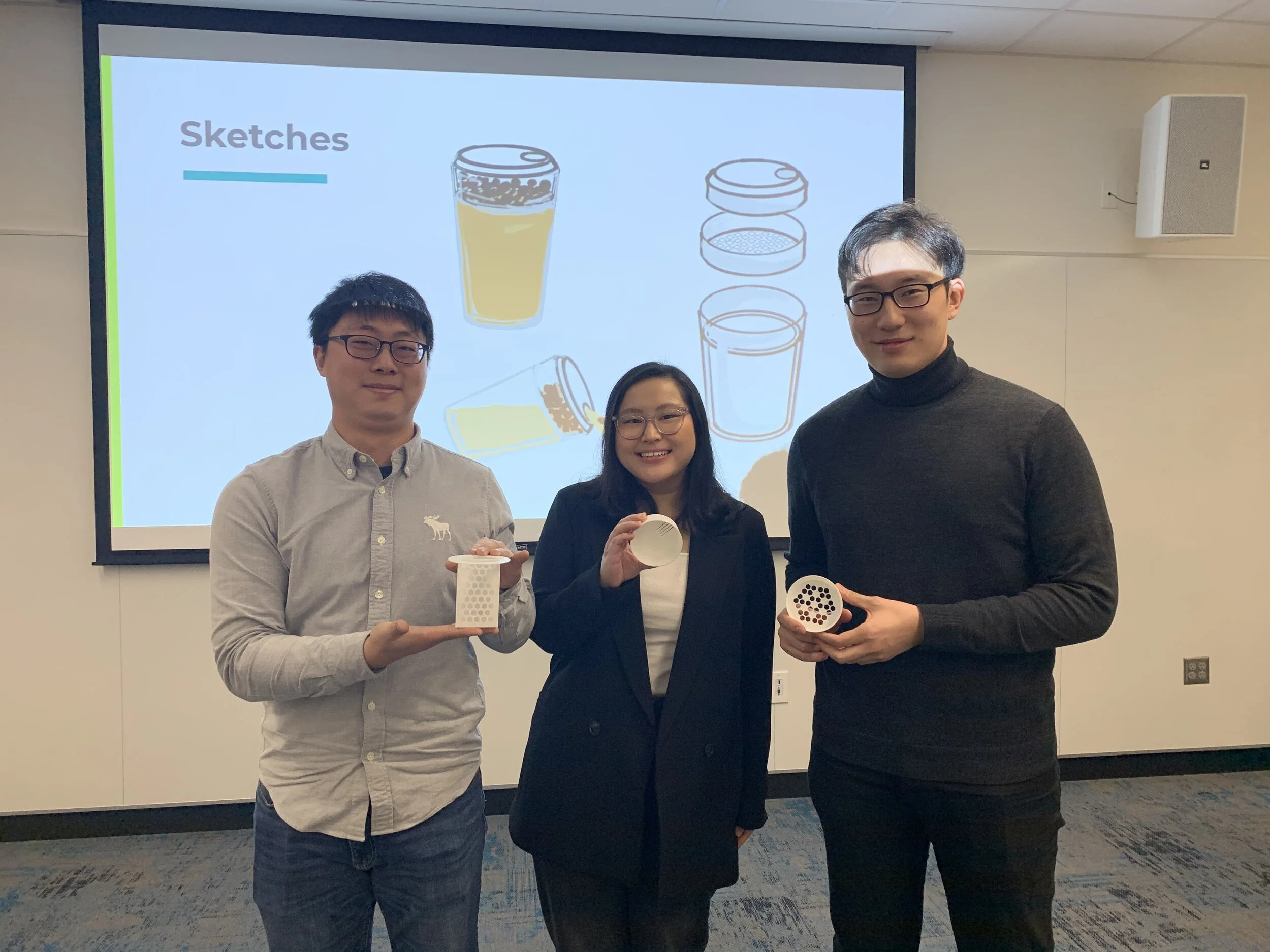Eliminating The Use of Plastic Boba Straws
In 10 weeks, my team used the human-centered design process to redesign the drinking experience of our favorite drink, boba (or bubble tea). Our goal was to reduce the use of plastic straws so that people can enjoy their sweet delicious drink in a more sustainable, environmentally-friendly way.
Team
Frank Zhou- mechanical engineer Chun-An Ku- business management
Timeframe
10 weeks September to December 2019
Skills
User research, usability testing, human-centered design process, business writing
My Role
As the sole designer working with teammates from both business and engineering background, I was able to lead us in the design process. I conducted user research, prototyped, and ran user testings.
Video Demo
Problem Statement
How might we help franchise and independent boba shops in Seattle eliminate the use of plastic straws, while maintaining drink quality and affordable costs, by the end of 2020?
The Challenge
Every day, there are around 500 million straws being used in America. In 2018, the city of Seattle came out with a Straw Ban that banned all plastic straw use within the city. However, according to our secondary research, the compliance rate among boba shops is at an astonishingly low 10%.
Our design question served as our guide for researching and building a solution throughout the 10 weeks, and it went through many iterations. At first, we assumed that boba shop customers were going to be our target users since they were the ones using straws to drink boba. However, we found later through field studies that customers did not care as much as we thought. They were limited to the straw options available to them. So we decided to set shop owners as our target users because ultimately they were making the straw purchasing decisions.
Our final design question emphasizes the importance of maintaining drink quality for customers while balancing costs for shop owners. We chose the greater Seattle area because we felt that it was appropriate for the scope of the project, and made potential users accessible for research and testing. The reason for setting a goal of 2020 was not only to be specific with our design question but also to comply with Washington state’s pre-filed legislation of a state-wide straw ban effective date.
User Research
We approached user research with 2 methods: field observations and surveys. As the UX lead of the team, I chose these two methods because I wanted to gather both qualitative and quantitative data under a 2-week timeframe. I considered interviewing as a method but decided that it may not be feasible under the time constraint. In addition, since our surveys had to be done in person (boba shop owners were not as accessible online), we were able to have some short, informal interviews during survey distribution. We first conduct field observations at local boba shops in Seattle. Then, based on what we learned in the field, we drafted a list of research questions under 3 areas of focus: users, business, and technology. From there, we designed and distributed a survey while conducting informal interviews with boba shop owners.
Field Observations
We chose 3 boba shops that each had a different straw situation: one with all compostable straws, one with all plastic ones, and one with both straws. We conducted 45-minute observations at each shop.
From field observations, we learned that customers don't care about what straws they use. In fact, no one brought any form of plastic straw alternatives or asked for no straws. Secondly, we learned that customers do not choose or buy straws since they pick whatever is available at the shop. These findings drove us to shift our target users from boba consumers to boba shop owners. We decided that because shop owners make the purchasing decisions of straws, therefore in order to reduce the use of plastic straws we have to develop an ideal solution for them.




Research Questions
Users
What are some of the challenges that Seattle boba shops are currently facing in regard to complying with the straw ban?
What are some of the factors that they consider when switching to non-plastic straws?
What do Seattle boba shop owners and their customers think of alternative straws?
Business
What’s the total addressable market of alternatives to plastic straws?
Who makes the decision of straw purchasing and what factors do they consider when making the purchase decision?
What are some of the trends within the beverage industry, especially in regard to straw use?
Technology
What are some good plastic straw alternatives?
How might we lower the cost of non-plastic straw manufacturing?
Surveys
Field observation validated some of our assumptions and led us to more unknowns. To answer those unknowns, we decided to draft a survey (link to survey) to send out to shop owners. Some of the questions we included:
What are some of the key factors that influence your straw buying decisions?
What are some of the challenges you face in switching to straw alternatives and complying with the law?
Not to anyone's surprise, finding boba shop owners who were willing to help with the survey was extremely difficult. In fact, surveying shop employees proved to be almost as hard. Countless boba purchases and a series of relentlessly trying later, we got 12 Seattle boba stores to fill out our survey with some owners agreeing to a 5-minute informal interview. This experience made me especially appreciate the amount of effort that goes into user research: real-world user data does not come easy. While we could have easily gotten more responses had we distributed the surveys to our boba-drinking friends, we would not have gathered the same valid information that only boba shop workers and owners could provide.
Insights
From field observation notes and survey results, we synthesized the following key insights:
Boba shop customers use whatever straws that are available to them at the boba shop.
Boba shop customers are not in the habit of bringing their own reusable boba straws.
Few shops provide an incentive for customers to bring their own straws or to use compostable straws available at the shop.
Cost is the key factor in shops’ straws offering. Both independent stores and chain stores face an increase in costs when switching to the current alternative- compostable straws.
Independent stores face bigger challenges on cost when they are asked to offer compostable straws compared to chain stores.
It is more difficult for independent stores to find sources for plastic straw alternatives due to the lack of connections to manufacturers as chain stores do.
Design Requirements
After analyzing our field observation (qualitative) and survey (quantitative) data, we triangulated our findings using an affinity diagram, and from there concluded a list of design requirements. Below are our top priority requirements:
User Experience
The solution should not add time to customers’ boba drinking experience.
The solution should not change the taste of any boba drinks.
Business
The solution should have similar costs as plastic boba straws.
The solution must be available to both independent shops and chain shops.
Technology
The manufacturing process of the solution must have a similar workload to manufacturing plastic straws
The solution and its manufacturing process should both be eco-friendly
Personas
A major finding from our primary research was the fact that independent and chain boba shops in Seattle sometimes face different problems regarding complying with the Straw Ban. To better illustrate those differences and each of their needs, we created two user personas to represent our target users.
Brainstorming
With our design requirements and personas in place, we started brainstorming possible solutions. As the UX lead, I encouraged all and especially wild ideas from the whole team. We ended up coming up with 8 possible solutions.
Downselection
Here’s how our idea selection process went after brainstorming:
First of all, while we realized that some of our "wild ideas" helped us in broadening our thinking to more possible solutions, a lot of them were not feasible. With this, we ruled out solutions such as "making higher density drinks so boba can float".
Secondly, we know that some of the solutions we brainstormed already exist in the market but are just not effective. We took those ideas out because it can be challenging for us to innovate or improve on solutions such as paper or pasta straws.
Last but not least, we reevaluated the scope of the project. With the size and background of our team, we felt that it would be nearly impossible to implement any law-related proposals. While we believed that imposing a higher import tax on plastic straws can be an effective way to address our design challenge, this solution was way beyond what a graduate student team could prototype.
Prototyping & Iterations
After comparing and analyzing the tradeoffs of each of our brainstormed ideas, we decided on a final solution to explore further: a separate cup component designed for boba that sits on top of the cup.
We first started by storyboarding our idea, and then quickly moved onto sketching by hand. We then drew a 3D model on Fusion 360 in which we printed later on using a 3D printer.
From our own experience of drinking boba, we knew that the boba will have to float in the cup in order to flow nicely into the user’s mouth when drinking. Because of that, we designed beehive-like holes on the bottom of the topping holder. To further help with boba flowing into the mouth, we also explored the idea of a vertical topping holder that sits along the side of a cup. Rather than designing our own, we used a grande-sized Starbucks cup as our Wizard-of-Oz boba cup. It was sufficient for rapid prototyping especially since most boba cups were around the same size.
From our own experience of drinking boba, we knew that the boba will have to float in the cup in order to flow nicely into the user’s mouth when drinking. Because of that, we designed beehive-like holes on the bottom of the topping holder. To further help with boba flowing into the mouth, we also explored the idea of a vertical topping holder that sits along the side of a cup. Rather than designing our own, we used a grande-sized Starbucks cup as our Wizard-of-Oz boba cup. It was sufficient for rapid prototyping especially since most boba cups were around the same size.




Pre-alpha Testing
With the two 3D printed prototypes, we decided to do a round of testing within the team. As 3 avid boba lovers, we did not want to pass on any opportunity to drink some boba, especially now without any plastic straw waste :)
During our pre-alpha testing, we found that boba tend to get stuck on the top layer of our vertical boba holder, which could irritate users who are trying to drink all the boba. On the other hand, the sit-on-top boba holder works almost perfectly. The only imperfection it had was the size of its beehive-like holes: they were a bit too big which caused us to get an excess amount of milk tea in comparison to the boba we got in each sip.
This round of early testing gave us many useful insights on how to improve our design for alpha testing. We decided to go with the top compartment design with modifications to the size of the holes. We changed the beehive-like holes into 4 parallel rectangular slots to better control the liquid-to-boba ratio. We then tried the newly printed designs and adjusted them a few times until all three of us could easily get an even proportion of milk tea and boba when drinking from the cup.






The Solution
After 2 rounds of pre-alpha testings, we felt good about our designed solution. It is a slotted boba topping holder that sits nicely on top of a cup, allowing users to drink boba drinks with an even distribution of boba and tea.
As cost was one our top priority design requirements, we did a cost analysis to determine the feasibility of our solution. We calculated the current cost of using a plastic straw, including the costs of sealing machines, sealing film, and plastic straws. We concluded that as long as our solution can cost below $0.1, we may be able to market it to boba shop owners.
Usability Testing
We tested our designs with 3 participants in total. Due to time and resource constraints, we conducted a within-subject experiment where all 3 participants each performed both shop employee and customer tasks. We encouraged all participants to think out loud, and gathered qualitative data by videotaping and taking notes throughout the testing sessions. We did not gather quantitative measurements for the following reasons:
1. Most of our testing subjects were not actual boba shop baristas, therefore it wasn’t feasible to get accurate results on things such as how fast they make a drink with our cup design in comparison to a regular cup;
2. Qualitative data (such as how a participant feels about using and drinking from the new cup) should give us plenty of insights on improving our solution’s practicality and desirability.



Key Findings
We were thrilled to find that everyone was so interested in our project. Many people even wished that our design was already being used by boba shops in Seattle. As one of our participants said after trying our prototype: “Why aren’t they using these already? It’s awesome.” Aside from the great enthusiasm we received, we also discovered a few usability issues.
Boba got stuck together if the drink swa left sitting for too long, which made it difficult for slow-drinking users to get any boba after the first 30 minutes.
Due to the size of the rectangular slots, the liquid dripped too slow when boba shop employees poured milk tea over the boba holder
Users struggled to identify the alignment of the lid to the slots on the boba holder due to the lack of signifiers.
The opening of the sippy lid has to align with the slots on the boba holder for the drink to flow, and we need a way for shop employees to easily identify the alignment thus reducing errors.
These issues were then ranked based on Nielsen’s Severity Rating for Usability Problems, and we were able to fix everything that had a rating of 3 or above (major usability errors). If we were to be given more time, we would have also liked to explore different material options including reusable plastic and silicon.
Sketches Credit: Frank Zhou
My Takeaways
Multidisciplinary collaboration is insanely powerful
Although I have worked with many multidisciplinary teams before, this was my first time being the only designer on the team. With two other teammates from engineering and business background, we were each able to provide insights from different perspectives. As a designer, I led us in following the design thinking process and guided the team when we went off-track during discussions.
Overall, I loved our team dynamic. We all came in with different skill sets that contributed to different aspects of the project. For example, Ku led us analyzing the marketability of our brainstormed ideas and Frank led the physical design of our 3D models. I especially appreciate the fact that despite us having different areas of expertise, we worked on every aspect of the project together and passed on our knowledge to other team members. (Shout out to Frank and Ku, because this project would not have been possible without the respect and support we had for each other.)
Defining the right scope is crucial to a project's success
One of the many things that we did well in this project was defining the right scope for the project. From a very early point on, our team decided to focus on eliminating plastic waste as our project objective. However, with my previous project experiences, I knew we had to narrow it down to an even more specific goal.
In the problem space of eliminating plastic use, we explored different plastic products such as plastic ziplock bags and plastic grocery bags. While both were issues worth addressing, we felt that there were too many existing solutions for them. We did not think designing yet another reusable ziplock bag or canvas shopping tote is gonna make a real difference in changing the status quo.
It wasn't long into our first meeting when we discovered our common interest in boba tea and the ridiculous amount of plastic waste we produce while drinking them. We also considered the timeframe of the project as well as the resources available to us. From there, we decided on a very specific design problem which served as our true north throughout our entire project.
Obtaining real-world data is difficult but so worthwhile
It was quite difficult to gather real-world data from boba shop owners and employees. Some of them rejected us due to them being busy, and some of them took less than 2 minutes to fill out our survey because they did not care. We spent an entire day going to 14 boba shops in Seattle and purchased at least one boba drink at each shop out of courtesy. Of the 14 we went to, 12 store owners agreed to fill out our survey and 10 of the results turned out to be valid.
While it was challenging (to say the least) to get valid responses, we did learn so much from everyone we talked to and think it was worth the extra effort. Not only did we gather usability information of current plastic straw alternatives, we also learned about the purchasing decisions behind buying different types of straws. Those insights greatly informed our design from both engineering and marketing perspectives.
Thinking beyond Design allows me to approach problems in a more comprehensive manner
Working closely with teammates from both an engineering and business background allowed me to think and do beyond my role as a designer. While this project emphasized on using the design thinking framework, my teammates and I never failed to consider the technology and business impact of our work.
In designing our final solution, we not only considered its usability, but also its technical feasibility and marketability. As a student Designer, it is rare for me to have the opportunity to integrate my work with engineering and business on this level. This project helped me gain a much better understanding of how Design fits into a product development cycle and how it can significantly affect business and engineering decisions.
Amongst all things I've learned from this project, I think this mindset of thinking beyond Design will follow me the furthest along into my future career. There will be plenty of opportunities for me to work on multidisciplinary teams in the future, and I now feel more prepared to contribute to any project as a Designer knowing my role and impact in the overall solution development process.








